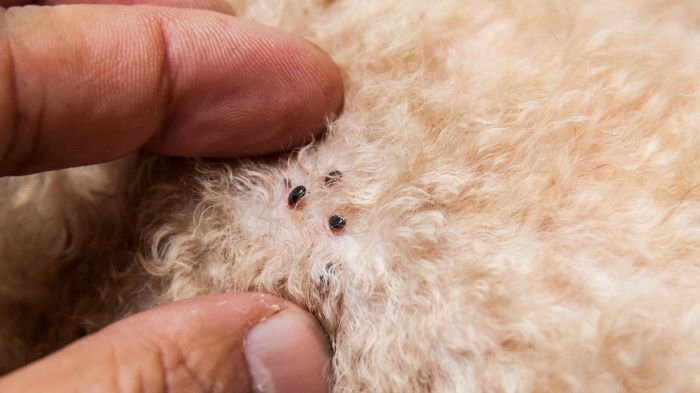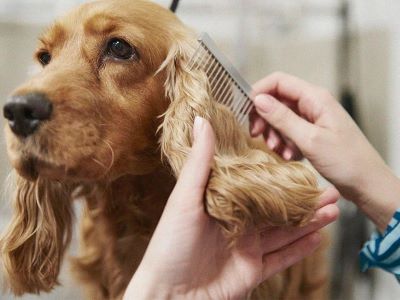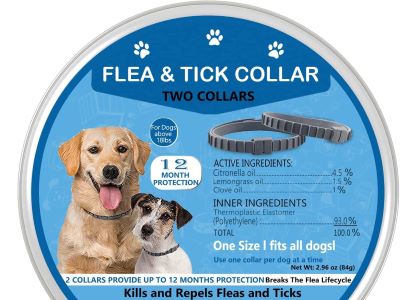Fleas can be extremely terrible, as anyone with a dog is likely aware. These little bugs may leap 150 times their own length and quickly infest your dog’s fur.
According to the American Veterinary Medical Association, fleas are the external parasite that affects dogs most frequently. Fleas are more than just a nuisance, though.

Your dog may experience severe health issues as a result of them. Your dog may experience itching, scratching, hair loss, and illness due to fleas. Understanding how to prevent and cure dog fleas is extremely important for this reason.
In this blog post, you will learn about the causes, prevention, and treatment of fleas on dogs. You will also discover some useful tips and resources that can help you keep your dog flea-free and healthy. Read on to find out more.
Contents
How Can I Get Rid of Fleas On Dogs?
If your dog is infested with fleas, you need to act quickly to get rid of them. Here are some ways that can help you remove fleas from your dog:
1. Use a Flea Comb
A flea comb is a tool that has fine teeth that can remove fleas and their eggs from your dog’s coat. You can use it every day to comb your dog’s hair, especially around the neck, ears, and tail.
Make sure to dunk the comb in soapy water after each stroke to kill the fleas. You can also use a flea comb to check if your dog has fleas by looking for black specks or white grains on the comb. These are flea feces and eggs, respectively.

2. Apply Medications
There are various medications that can remove fleas from your dog, either orally or topically.
Some examples are nitenpyram, fipronil, and imidacloprid.[1] These medications can remove adult fleas within hours and prevent reinfestation for weeks or months.
However, you should always consult your vet before using any medication and follow the instructions carefully. Some medications may have side effects or interactions with other drugs or conditions.
You should also keep them out of reach of your dog and children to avoid accidental ingestion or overdose.
3. Try Home Remedies
There are also some home remedies that can help you get rid of fleas from your dog.[2]
Some common ingredients that have anti-flea properties are baking soda, salt, diatomaceous earth, apple cider vinegar, lavender oil, and garlic.
You can sprinkle these ingredients on your dog’s coat, bedding, or furniture and vacuum them up after a few hours. You can also spray or rub them on your dog’s skin or add them to their water or food.
However, you should be careful with the dosage and frequency of these remedies as they may cause irritation or toxicity in some dogs. You should also check with your vet before using any home remedy.
How Do I Know If My Dog Has Fleas?
Fleas are small, brown, wingless insects that feed on the blood of animals and humans. They can be hard to spot on your dog’s coat, but there are some signs and symptoms that can indicate a flea infestation. These include:
1. Itching: Your dog may scratch excessively or bite at their skin to relieve the itchiness caused by flea bites. This may be more noticeable in areas where fleas tend to congregate, such as the neck, ears, and tail.
2. Scratching: Your dog may develop redness, inflammation, or scabs on their skin from scratching too hard or too often. This may lead to secondary infections or skin conditions.

3. Hair Loss: Your dog may lose patches of hair due to excessive scratching or biting. This may expose their skin to further irritation or infection.
4. Infections: Your dog may develop bacterial or fungal infections on their skin or ears from flea bites or scratching wounds. These may cause pus, odor, discharge, or crustiness on the affected areas.
5. Anemia: Your dog may become anemic if they lose too much blood from flea bites. This may cause pale gums, weakness, lethargy, or weight loss.
If you notice any of these signs or symptoms in your dog, you should check them for fleas using a flea comb or a white towel. You should also take them to the vet for proper diagnosis and treatment.
Which Sources Infesting Fleas on Your Dogs?
Fleas are tiny, wingless, brown insects that feed on both human and animal blood. They could infest the fur of your dog. Also, they can infect your dog with illnesses and parasites. But from where do fleas originate? The following are some typical origins of canine flea infestations:
1. Other Animals: One of the most common ways for fleas to infest your dog is through contact with other animals that have fleas. These can be other pets or wildlife that come into your home or yard.
For example, cats, rabbits, squirrels, rats, or raccoons can carry fleas and transfer them to your dog. Fleas can also jump from one host to another when they are in close proximity.

2. Outdoor Environment: Another common source of flea infestation on dogs is the outdoor environment. Fleas can thrive in warm, humid, and shady areas, such as grass, soil, or leaves.
They can also hide in cracks and crevices in wood, stone, or concrete. If your dog spends a lot of time outdoors or likes to dig or roll in the dirt, they may pick up fleas from these places.
Fleas can also hitch a ride on your shoes or clothes and enter your home.
3. Poor Hygiene: A third common source of flea infestation on dogs is poor hygiene. Fleas can multiply quickly if your dog is not groomed or bathed regularly.
Dirt and debris on your dog’s fur can attract fleas and provide them with a suitable environment to lay eggs. Flea eggs can also fall off your dog’s fur and infest their bedding or furniture.
If you don’t wash your dog’s bedding or toys in hot water or vacuum your carpets or upholstery frequently, you may create a flea haven in your home.
How to Prevent Fleas from Infesting Your Dog?
The best way to deal with fleas is to prevent them from bothering your dog in the first place. Here are some tips on how to prevent fleas from infesting your dog:
1. Brush Your Dog Regularly: Brush your dog’s coat daily and bathe them once a month with a mild shampoo to remove dirt and debris that may attract fleas.
You can also use a flea shampoo that contains pyrethrins or permethrin that can remove fleas on contact and prevent reinfestation for a few weeks.
2. Use a Flea Collar: Use a flea collar that contains insecticides or repellents that can remove or repel fleas for several months. You should replace the collar every few months or as instructed by the manufacturer.
You should also make sure the collar fits snugly but not too tightly around your dog’s neck.

3. Try Natural Remedies: Use some natural ingredients that have anti-flea properties, such as apple cider vinegar, lavender oil, or garlic. You can spray or rub them on your dog’s skin or add them to their water or food.
However, you should be careful with the dosage and frequency of these remedies as they may cause irritation or toxicity in some dogs. You should also check with your vet before using any natural remedy.
4. Control Your Environment: Keep your home and yard clean and free of fleas by vacuuming regularly, washing your dog’s bedding and toys in hot water, and disposing of any trash or debris that may harbor fleas.
You can also use some natural or chemical products that can remove fleas and their eggs and larvae in your environment, such as borax, boric acid, diatomaceous earth, nematodes, or insect growth regulators.
FAQs
What kills fleas immediately on dogs?
Some products that can kill fleas immediately on dogs are nitenpyram, spinosad, fipronil, and imidacloprid. These products can kill adult fleas within hours and prevent reinfestation for weeks or months. However, you should always consult your vet before using any product and follow the instructions carefully.
Can you treat fleas on dogs at home?
Consult your vet before using home remedies or over-the-counter products to treat fleas on dogs. Follow instructions carefully and monitor your dog’s response. Seek veterinary attention for severe or persistent flea problems.
What naturally kills fleas?
Baking soda, salt, diatomaceous earth, apple cider vinegar, lavender oil, and garlic can kill fleas on dogs by dehydrating, disrupting pH balance, or repelling them. Be cautious with dosage and consult your vet before using natural remedies to prevent potential irritation or toxicity.
Does Coconut Oil Kill Fleas?
Coconut oil kills and prevents fleas with lauric acid. It heals flea bites and infections. It can be applied or ingested. It can be mixed with essential oils. It is safe and natural.
Conclusion
Fleas are a serious issue for dogs and their owners. They can lead to itching, scratching, hair loss, infections, and anemia in dogs. They can also spread diseases and parasites to dogs and humans.
You have various options to remove fleas from your dog, such as flea combs, medications, or home remedies. You should also maintain your home and yard clean and flea-free by vacuuming, washing, and disposing of any flea sources.
If you have any doubts or worries about fleas on your dog, you should always consult your vet for expert advice and treatment. Remember, “Prevention is better than cure” when it comes to fleas on dogs.
Keep your dog happy and healthy by following these simple steps. Thank you for reading this blog post. I hope you found it helpful and informative.
References:
- Schenker, R., Tinembart, O., Humbert-Droz, E., Cavaliero, T., & Yerly, B. (2003b). Comparative speed of kill between nitenpyram, fipronil, imidacloprid, selamectin and cythioate against adult Ctenocephalides felis (Bouché) on cats and dogs. Veterinary Parasitology, 112(3), 249–254. https://doi.org/10.1016/s0304-4017(02)00425-9- ScienceDirect
- Guest. (2004, March 12). Flea Recipes [Online forum post]. IndiaDivine.org. Retrieved June 2, 2023, from https://www.indiadivine.org/content/topic/1791180-flea-recipes/- IndiaDivine

Dania is a dog groomer living in California, who loves styling dogs. She often uses dog accessories to keep them distracted while grooming. She is also a dog parent to a Pomeranian, Duke. It’s because of him she is always on a lookout for the best dog foods, toys, other dog accessories, and ways to keep him equipped, healthy and happy.


